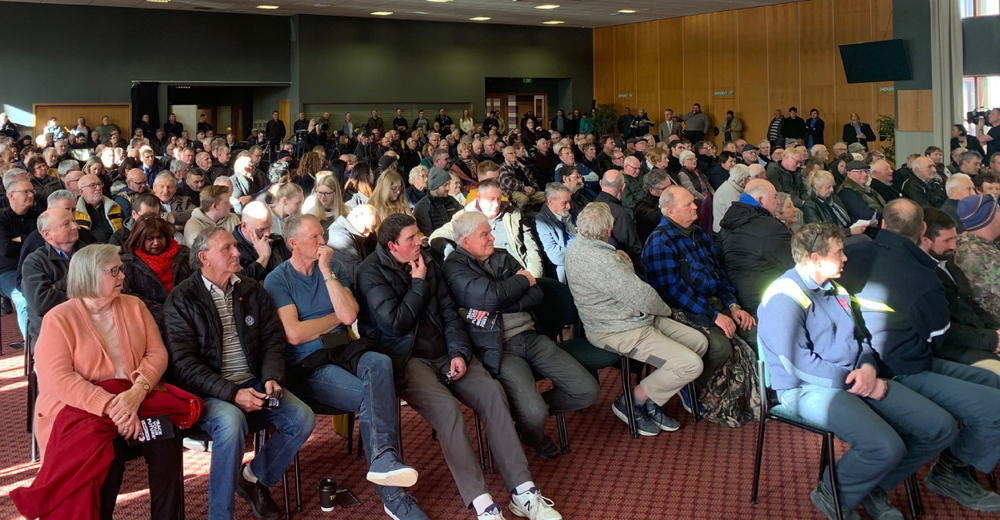New Zealanders "lied to" over the true cost of Tiwai power
Lucy Henry
24 July 2020, 7:02 AM
 Winston Peters and Mark Patterson at the 'Join The Fight For Tiwai' meeting today
Winston Peters and Mark Patterson at the 'Join The Fight For Tiwai' meeting todayNew Zealanders have been fed a lie for decades that the Tiwai Point aluminium smelter’s electricity has been subsidised, New Zealand First leader Winston Peters told a crowd in Invercargill this afternoon.
“That’s been a lie since 1977, a year before I entered Parliament, and is just as big a lie today,” he said.
The smelter produced the finest aluminium in the world, Mr Peters said.
“And if it and its workers were not the victim of deceitful, appalling, political propaganda it would last for decades to come.”
“My party is here today to oppose any idea of closure and to promise that if we go on having a say in government, then we commit to a 20-year agreement with a 10 year review, with a fair electricity cost based on the cost of supply and a respectable margin.”

Mr Peters said a worker buyout, although possible, would not be necessary to secure the smelter’s future if the government would commit to lowering energy costs.
“And what’s a respectable margin? Something like the original agreement of 10% when this great enterprise first started.”
The meeting, 'Join The Fight to Save Tiwai', was organised by New Zealand First. Mr Peters told the crowd of about 400 who turned out that New Zealand’s Aluminium Smelter (NZAS) currently uses 2% Transpower’s network but pays 8% of its costs.
"That is $50 million each year," he said.
He refuted the narrative that Tiwai's electricity had been subsidised by the government, saying instead it breached initial agreements, when the smelter was founded by Comalco, by demanding "extortionate increases" in electricity pricing to the smelter.
"I’ve got with me the legislative foundation of this smelter... it sets out the actual cost of supply of electricity plus a 10% margin."
"The 10% margin dramatically increased to the great benefit of the Crown, and destruction of the smelter’s competitiveness."
And if the smelter did close, Mr Peters said the $50 million of transmission costs currently paid by Rio Tinto, would only be absorbed by the residential and commercial electricity consumers of New Zealand.
During a visit to Invercargill last week, prime minister Jacinda Ardern said there were no plans to keep the smelter open or offer Rio Tinto any sort of bailout. Rather, the government was focused on securing a longer transition period (the smelter is currently scheduled to cease operating in 14 months).
Mr Peters was then accused this week of "scuppering" the government's planned announcement of a $100 million government cash injection for the Southland region to boost the economy and help create jobs.
The announcement was supposedly meant to be made during the Prime Minister's visit to Invercargill last week, however, Mr Peters today said if honesty and common sense were not restored to this issue there would be disastrous effects here and across the country.
“Sadly, with all the deceit and political interference much of that hope has been lost. But this smelter could be revived again and go on making a significant contribution to Southland and New Zealand,” Mr Peters said.
“If we go down this pathway of abandoning Tiwai Point in favour of a transition package, as some politicians would advocate for, the results will be dwarfed by what happens here and the wider impact on employment across New Zealand,” he said.
“Tiwai contributes over $450 million annually to Southland and New Zealand, and 2600 families depend upon it. A one off ‘$100 million tea and sympathy fund’ won’t even touch the sides down here.”
The “tragic irony” was that South Island hydro would be forced to spill and waste water because of transmission constraints. And the result of all this “unnecessary increased volatility” would undermine further investment in New Zealand, lead to disproportionately high job losses in the region, and export that carbon impact at a time when New Zealand was striving for a “carbon-neutral New Zealand”.
“Right now, we are producing clean aluminium using green energy in New Zealand. If there is closure here then our aluminium production will be substituted with aluminium production offshore, produced using coal and gas overseas.”
Mr Peters said it was “breath-taking” this debate was being held without the presence of those directly affected.
“As though you don’t matter; as though you are just collateral damage.”
Mr Peters concluded by calling on those present to vote for him if they want to see Tiwai saved.
“It goes like this; you vote for me first and then I’ll deliver it.”
“You need to buy yourself some insurance down here and you’re looking at it.”
AG | TRADES & SUPPLIES
OLD NOTICES | JOBS








